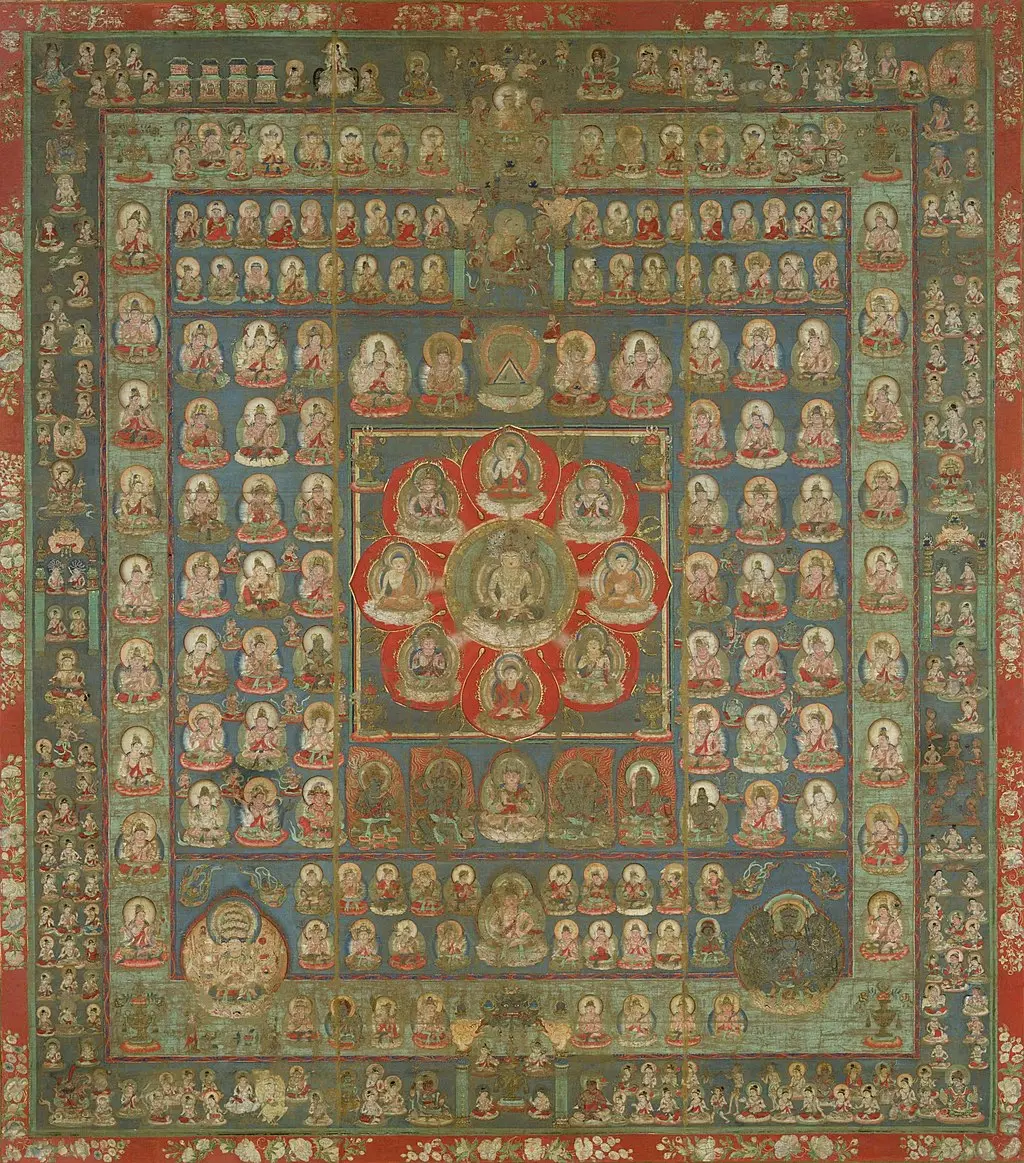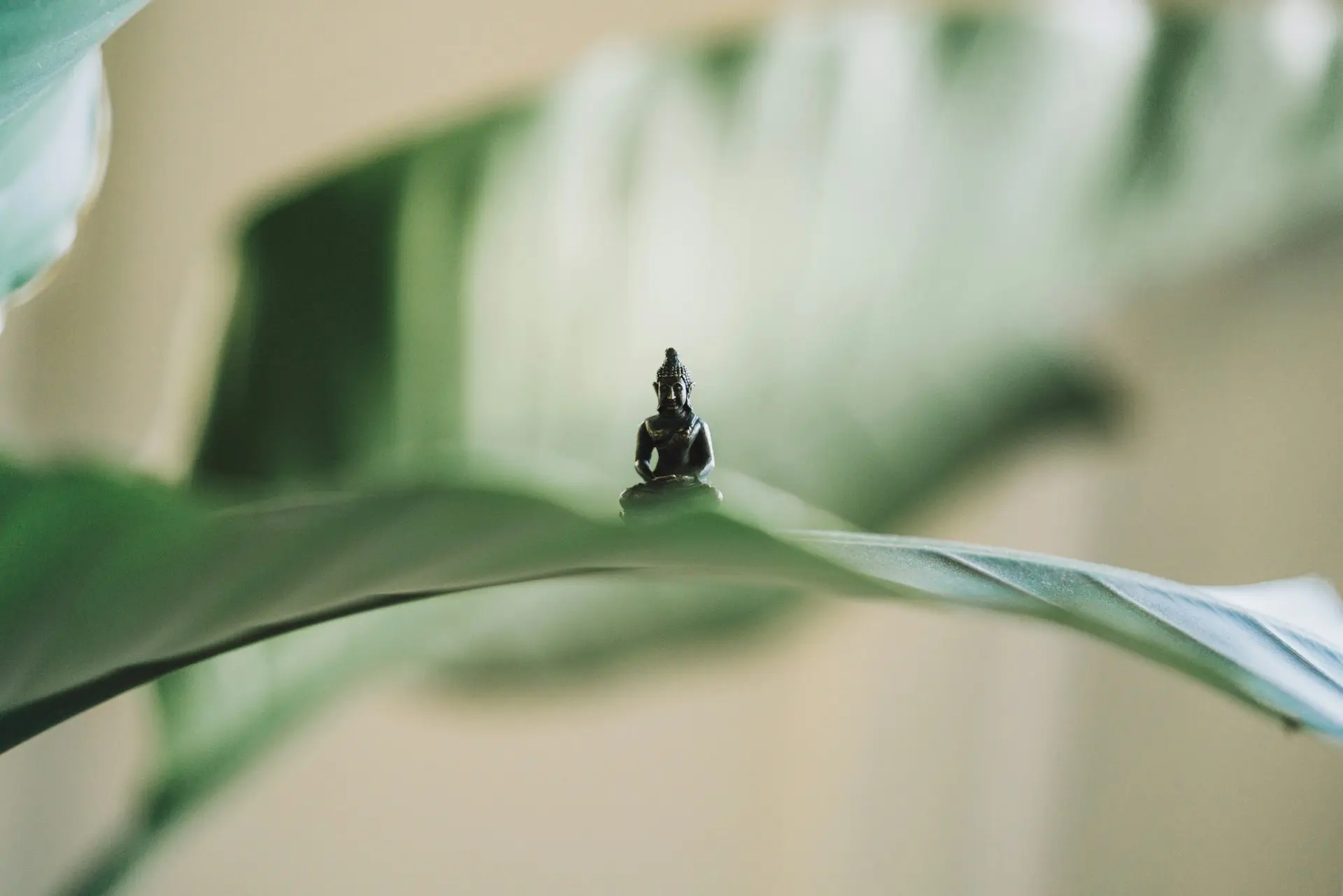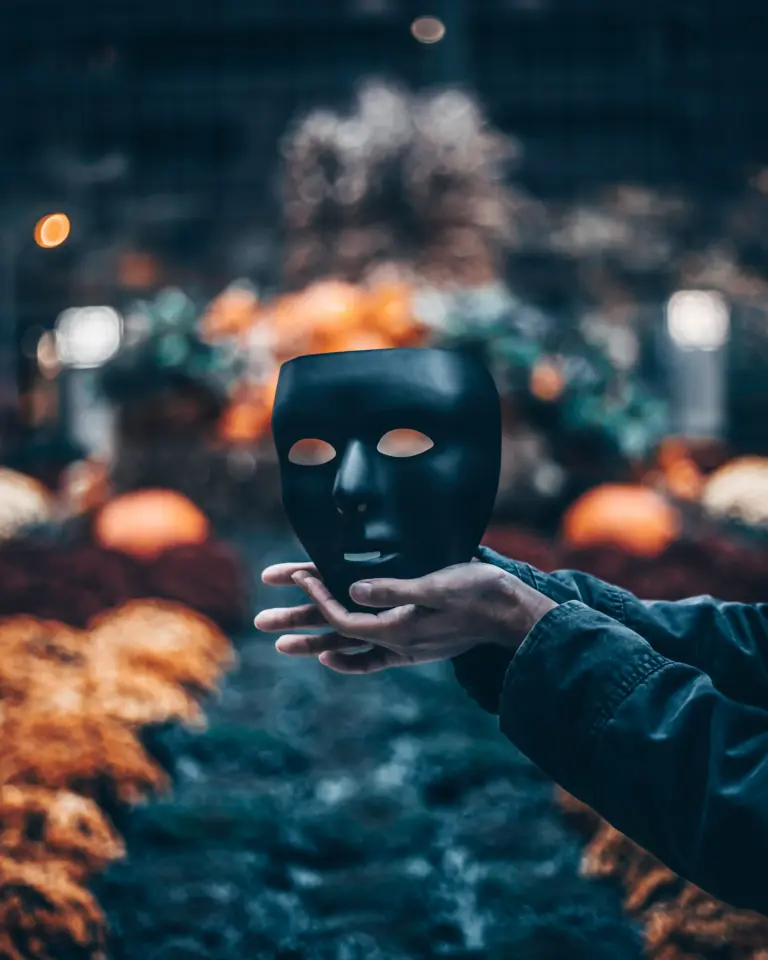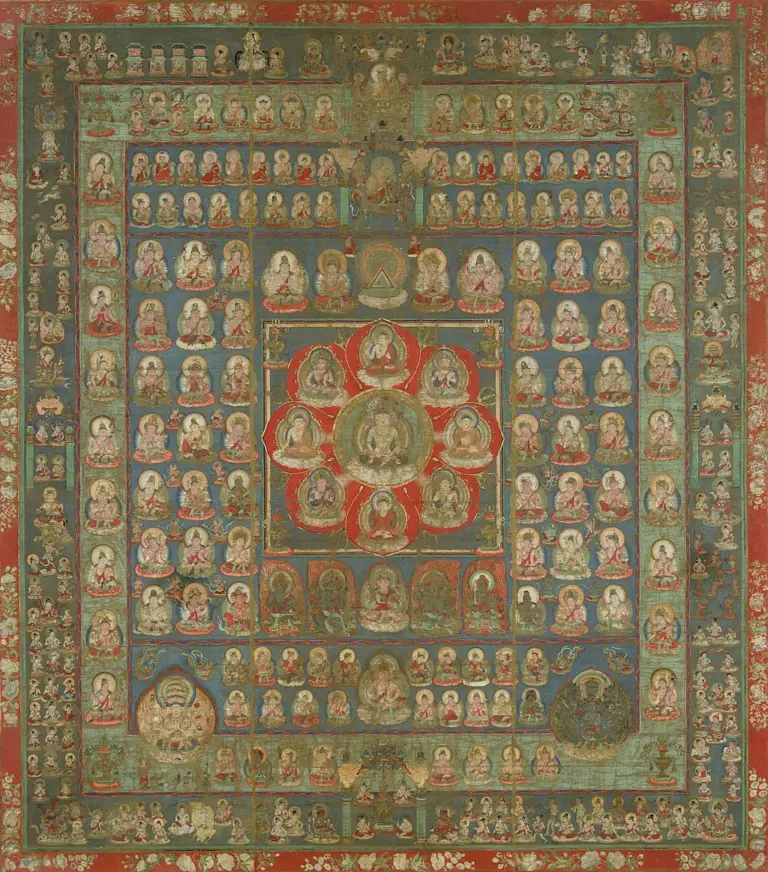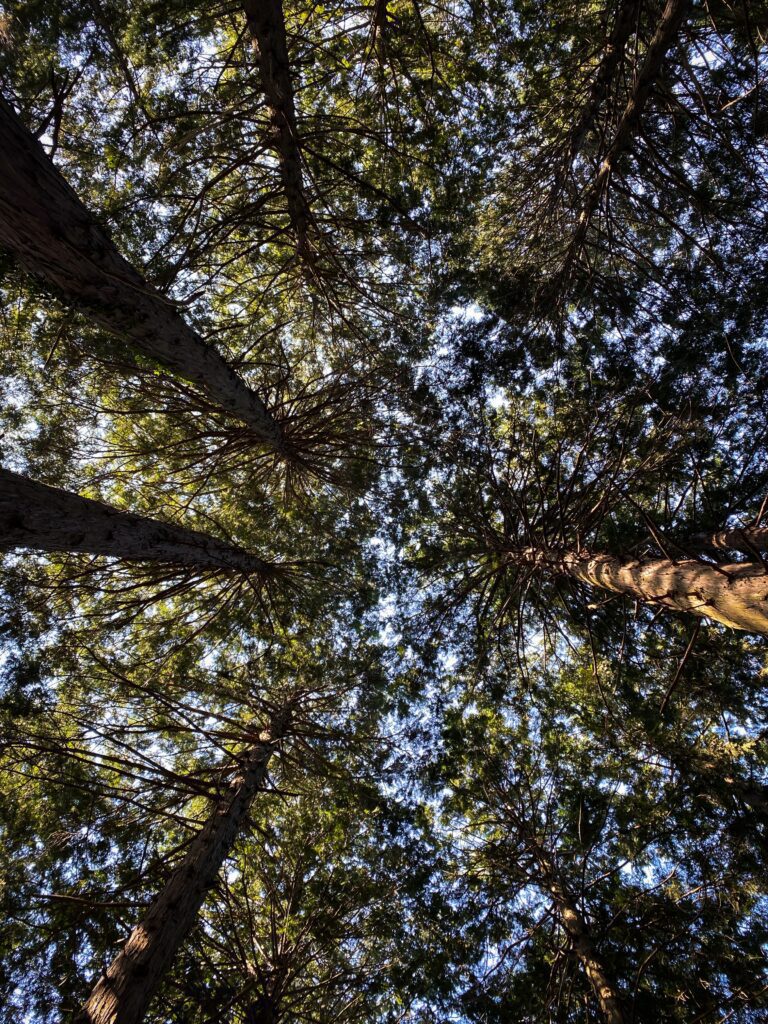Dive into the deep, tranquil pool of Mahayana Buddhism, a religious philosophy with centuries of wisdom, practices, and beliefs that have shaped the lives of millions around the globe.
In this blog post, we’ll explore the essence of Mahayana Buddhism, uncovering its profound principles and transformative teachings. I hope that it will be able to provide you with a comprehensive overview while offering valuable insights!
Table of Contents
ToggleWhat is Mahayana Buddhism?
Mahayana Buddhism is one of the main branches of Buddhism, standing alongside Theravada and Vajrayana.
The term Mahayana, which translates to “The Great Vehicle,” is an apt descriptor. The tradition is so named because it aspires to carry all beings to the other shore of enlightenment, reflecting its emphasis on compassion.
Originating around the first century BCE in India, Mahayana Buddhism has grown to become the most widely-practiced branch of Buddhism, spreading far and wide throughout Asia.
Mahayana Buddhism distinguishes itself from other branches through several unique beliefs and practices. Key among these are the concepts of the Bodhisattva ideal and emptiness (we’ll get to these later).
Another distinctive aspect of Mahayana Buddhism is its recognition and acceptance of many different Buddhas and Bodhisattvas, as well as its incorporation of a rich array of sutras.
Mahayana Buddhist Terms to Remember
-
Bodhisattva: In Mahayana Buddhism, a Bodhisattva is a being who has taken a vow to achieve Buddhahood for the benefit of all sentient beings. They have accumulated enough merit and wisdom over countless lifetimes, yet they choose to postpone their own enlightenment until they help all other beings reach this state.
-
Samsara: This is the cycle of birth, death, and rebirth in Buddhism. The goal for all practicing Buddhists is to escape this cycle and achieve Nirvana.
-
Nirvana: This is the ultimate spiritual goal in Buddhism, the state of liberation and enlightenment where one is free from suffering and the cycle of rebirth.
-
Dharma: This refers to the teachings of the Buddha. In a broader sense, it’s used to describe the universal laws that uphold the cosmos.
-
Sutra: These are discourses given by the historical Buddha or in some cases, by revered Bodhisattvas in Mahayana texts. The word literally means a “line that holds things together”.
-
Karma: Karma refers to the law of cause and effect. It is the idea that every intentional action, whether they are good or bad will have an equivalent consequence.
Who are the Major Figures in Mahayana Buddhism?
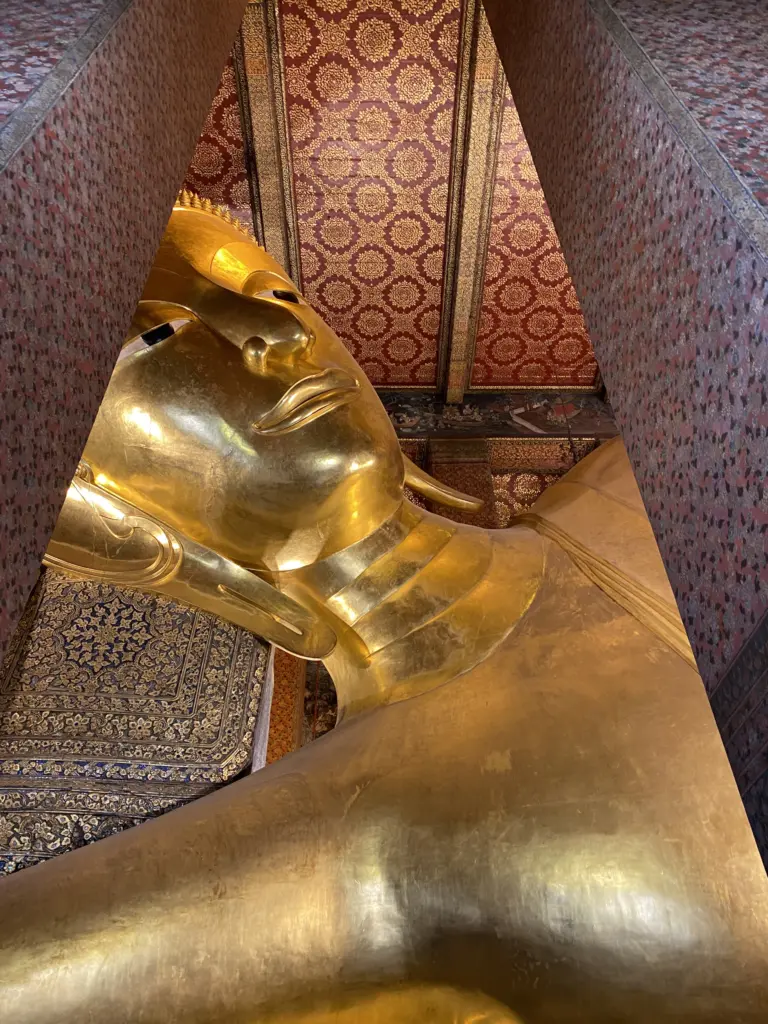
Shakyamuni Buddha
Also known as Siddhartha Gautama or simply the Buddha, is the original and historical Buddha who lived approximately 2,500 years ago. Born into a royal family in the kingdom of Shakya in present-day Nepal, he was privileged with a life of luxury.
However, he became disillusioned by the suffering he saw in the world around him and decided to renounce his royal status, family, and wealth to embark on a spiritual journey.
After several years of ascetic practices and meditation, Siddhartha achieved an enlightened state known as Nirvana under the Bodhi tree in Bodh Gaya, India.
After attaining enlightenment, he became known as Shakyamuni, which means “sage of the Shakya clan.” He spent the rest of his life teaching the path to enlightenment that he had discovered, which is known as the Dharma.
In Mahayana Buddhism, Shakyamuni Buddha is revered as the historical Buddha but is also seen as one manifestation of the eternal Buddha nature that is inherent in all beings. His life and teachings serve as a guide and inspiration for Buddhists to follow on their own path to enlightenment.
The photo I took in Bangkok’s Wat Pho has one of the biggest reclining Buddhas in the country, and yes that’s the Shakyamuni Buddha!
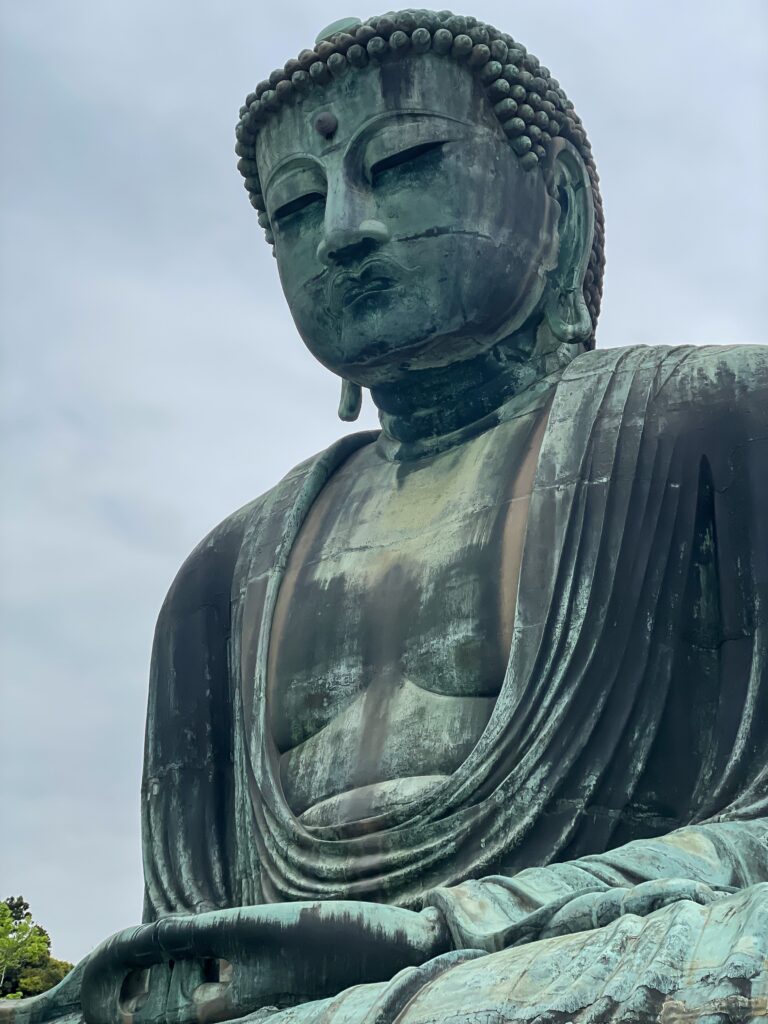
Amitabha Buddha
Amitabha is also known as the Buddha of Infinite Light and Life, is one of the most revered figures in Mahayana Buddhism. He is particularly significant in Pure Land Buddhism, a major school of Mahayana, which is widely practiced in East Asia.
He is also one of the Five Cosmic Buddhas which you can read more about here!
In Japan, the Big Buddha in Kamakura is actually Amitabha Buddha, or Amida Butsu in Japanese. He is commonly seen holding the Dhyana Mudra but the Japanese version holds a variation of it with the finger knuckles touching.
According to Mahayana scriptures, Amitabha Buddha was once a king who renounced his throne to become a monk named Dharmakara.
The monk Dharmakara made a series of vows, the 18th of which promised that, upon his achieving Buddhahood, all beings who called upon his name with faith and wished to be reborn in his realm would achieve rebirth there and could attain enlightenment.
This realm, known as the Pure Land, is said to be an ideal environment for Buddhist practice, free from the distractions and hardships of our own world.
After countless ages of diligent practice, Dharmakara became Amitabha Buddha and established the Pure Land, fulfilling his vows. He is often depicted seated on a lotus throne, with his hands in the gesture of meditation, symbolizing the serenity and concentration that leads to enlightenment.
The practice of invoking Amitabha’s name, often referred to as nianfo or nembutsu, is a popular form of devotion in Mahayana Buddhism, especially in Pure Land Buddhism. It is believed that sincere recitation of his name, usually in the form “Namo Amitabha Buddha,” ensures rebirth in the Pure Land where one can pursue enlightenment with Amitabha’s guidance.
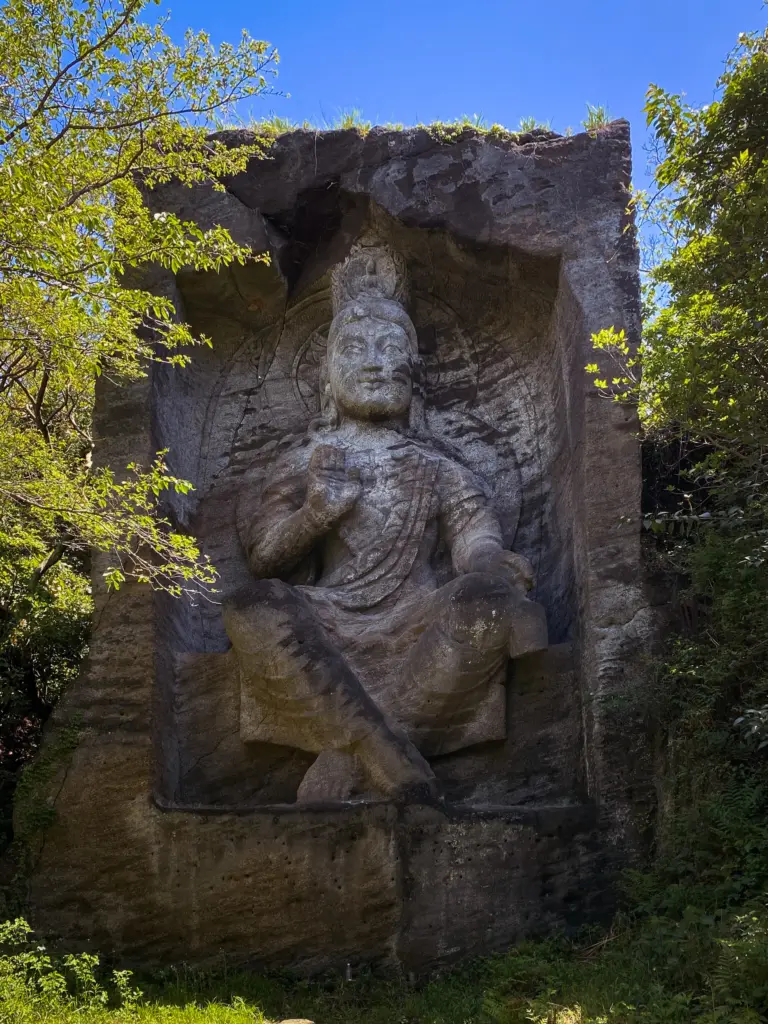
Maitreya Buddha
Maitreya Buddha is also known as the Buddha of the Future. According to Buddhist tradition, Maitreya is a bodhisattva who will appear on Earth in the future, achieve complete enlightenment, and teach the pure dharma.
The prophecy of the arrival of Maitreya refers to a time in the future when the teachings of Gautama Buddha will have been forgotten in this world. At that time, Maitreya will descend from the Tusita Heaven, where he currently resides, be reborn as a human, achieve enlightenment, and take up the role of a teacher to continue the lineage of Buddhas. (It’s quite similar to the prophecy of Kalki, from Hinduism)
Maitreya Buddha is often depicted seated with his feet on the ground, indicating his readiness to rise to his task when the time comes. I was quite lucky to find a huge sculpture of him in Mt. Takatori.
Interestingly, Maitreya is viewed not just as a future teacher but also as a symbol of hope and the potential for all beings to achieve enlightenment.
Bodhisattva Manjushri
Meet Manjushri, the Bodhisattva of Wisdom. This bodhisattva is no ordinary figure – Manjushri carries a flaming sword in his right hand, which symbolizes the power of wisdom to cut through ignorance and delusion, the root causes of suffering in Buddhist teachings.
Ever seen a bodhisattva riding a lion? Well, that’s Manjushri for you. The lion, a symbol of courage, perfectly represents Manjushri’s fearless pursuit of enlightenment and his unswerving devotion to the truth.
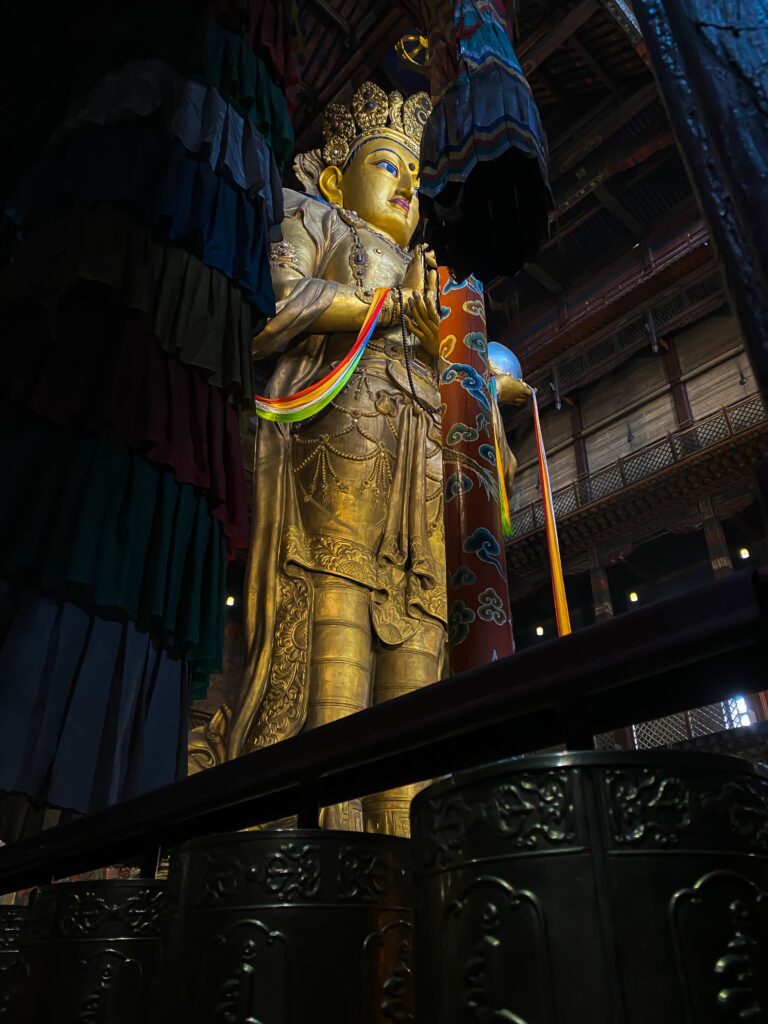
Bodhisattva Avalokiteshvara
Avalokiteshvara is interesting because he (or she) has many names and forms. He is known as Guanyin in Chinese countries or Kannon in Japan where he actually became a she, having a feminine form. Avalokiteshvara is known as the Bodhisattva of Compassion, and his name can be translated as “The Lord Who Hears the Cries of the World.”
Avalokiteshvara embodies the compassion of all Buddhas and is believed to be the listener of the world’s cries, coming to the aid of those who call upon him during suffering. He is often depicted with multiple arms, each representing a different aspect of compassion. In some traditions, Avalokiteshvara is portrayed with a thousand arms and eleven faces, signifying his endless capacity to perceive suffering and extend his mercy and compassion towards all beings.
Bodhisattva Avalokiteshvara is also associated with the famous mantra “Om Mani Padme Hum“, often translated as “The jewel is in the lotus”.
In Mongolia‘s capital city, Ulaanbaatar, there’s a giant golden statue of Avalokiteshvara where plenty of devotees pray to.
What are the Sacred Texts of Mahayana Buddhism?
In Mahayana Buddhism, there are many sacred texts, often referred to as sutras, that are considered important for understanding the teachings of Buddha and the path to enlightenment. Here are some of the key ones:
Lotus Sutra (Saddharma Pundarika Sutra): One of the most influential and important Mahayana sutras, the Lotus Sutra is known for its extensive instruction on the concept and the role of a bodhisattva. This text is particularly noted for its teaching that all beings can achieve Buddhahood.
Heart Sutra (Prajnaparamita Hridaya Sutra): This sutra is one of the shortest, yet most profound, with its deep teachings on emptiness (sunyata) which you can read more about here.
Diamond Sutra (Vajracchedika Prajnaparamita Sutra): This short and well-known sutra discusses the practice of non-abiding and non-attachment. It is famous for its teaching on the nature of reality.
What are the Core Beliefs of Mahayana Buddhism?
Buddhas and Bodhisattvas
In Mahayana Buddhism, the universe is thought to be filled with a multitude of Buddhas and Bodhisattvas. They are revered for their extraordinary qualities, teachings, and vows to help sentient beings achieve enlightenment.
Unlike Theravada Buddhism, which primarily focuses on the life and teachings of the historical Buddha, Siddhartha Gautama, Mahayana Buddhism posits the existence of countless Buddhas and Bodhisattvas across limitless world systems. Each of them is seen as a manifestation of the ultimate Buddha-nature and is often associated with specific qualities.

Sunyata (Emptiness)
Emptiness, don’t let the word fool you. It doesn’t mean “nothingness” in the way we usually understand it. Sunyata is about understanding the nature of existence and reality in a deeper way.
In Mahayana Buddhism, the idea is that all things are interconnected and interdependent. Nothing exists in isolation, and nothing has an independent, fixed self.
It’s like looking at a tree – you can’t really separate the tree from the sunlight it needs to grow, or the soil it’s rooted in, or the rain it drinks. They’re all part of the existence of the tree.
So, when we say things are “empty” in the context of Sunyata, it means they’re empty of independent existence. They’re part of this vast, interconnected web of causes and conditions.
This doesn’t mean things don’t exist at all. Rather, they exist in a way that is constantly changing and interrelating with everything else.
If you want to read more about the concept of emptiness, you can click here.
Tathagatagarbha (Buddha-nature)
Buddha-nature essentially refers to the potential within all sentient beings to achieve Buddhahood. Think of it as an innate seed of enlightenment within each of us, just waiting to be nurtured and realized.
The concept implies that enlightenment isn’t an external state to be attained, but rather an inherent potential to be uncovered. Like the sun that’s always shining behind the clouds – it’s always there, even when obscured.
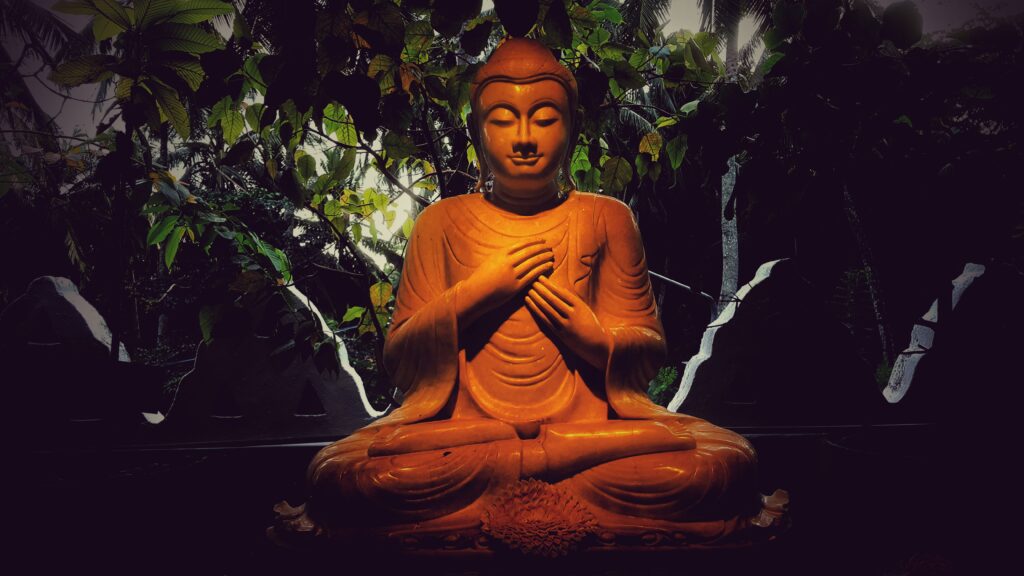
What are the Core Principles of Mahaya Buddhism?
The Six Paramitas (Perfections)
The Six Paramitas outles the qualities that one must cultivate on the path to becoming a Bodhisattva. These are:
Dana Paramita (Perfection of Generosity): This encompasses giving freely without expecting anything in return. It can be material gifts, but it also includes the gift of teaching and the gift of fearlessness, providing comfort to those in need.
Sila Paramita (Perfection of Morality): This involves living an ethical life in accordance with the precepts of Buddhism. This means avoiding harm to others, behaving honestly, and cultivating virtuous qualities.
Kshanti Paramita (Perfection of Patience): This is the ability to bear hardships, suffering, and insult without becoming angry. It’s a state of mind where one is able to accept the world as it is without agitation.
Virya Paramita (Perfection of Energy): This pertains to the effort directed toward the achievement of enlightenment and the relief of suffering in others. It’s about having the diligence to overcome obstacles and sustain practice.
Dhyana Paramita (Perfection of Meditation): This is about cultivating a clear, tranquil mind through practices like mindfulness and meditation. It’s about achieving a state of mind that is undisturbed by distraction.
Prajna Paramita (Perfection of Wisdom): This is the culmination of the other perfections, and it refers to the insight into the nature of reality, understanding the emptiness of all phenomena, and transcending the limitations of conventional wisdom to attain the wisdom of a Buddha.
They’re called “perfections” because they represent the culmination of certain virtues, but it doesn’t mean you need to execute them flawlessly to make progress on the path to enlightenment. Buddhism recognizes that we’re all human, with our own strengths and weaknesses, and the path to enlightenment is a journey that requires patience, diligence, and time.
It’s less about achieving an impossible standard of perfection, and more about continuously striving to cultivate these virtues for the benefit of others.
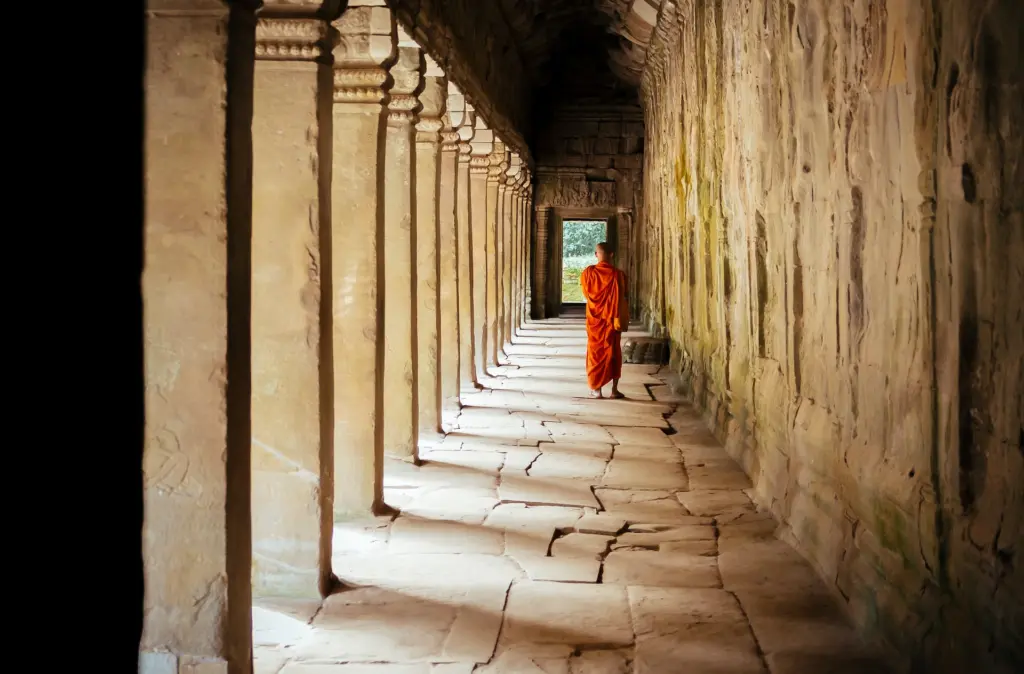
Bodhisattva Ideal
The Bodhisattva Ideal really gets to the heart of Mahayana Buddhism. It’s the aspiration that many followers of Mahayana Buddhism strive to reach.
You know how in some religions there’s this idea of getting to a better place like heaven? And usually it’s a personal journey, right? Well, the Bodhisattva Ideal takes this concept and spins it on its head a bit. Instead of focusing only on personal enlightenment, it’s about seeking enlightenment for the benefit of all beings. All beings, not just yourself!
Upaya (Skillful Means)
Skillful means or “upaya” in Sanskrit, means the ability to adapt the teachings of Buddhism to the needs of different individuals.
Think of it like this: not everyone learns in the same way. Some people might respond best to stories, others to direct teachings, and others still to personal experiences. Skillful means is about understanding these differences and tailoring the approach to the teaching of Dharma accordingly.
This concept can be applied to the teachers and students but it can also be interpreted in a larger scale as in the Buddha and us, as students.
Upaya is said to be used by Bodhisattvas and Buddhas, who, in their deep wisdom and compassion, adjust their teachings to the spiritual maturity and understanding of their audience. This way, they can guide beings on the path of enlightenment effectively. It’s kinda like the Buddha’s tailor-made curriculum just for you!
A classic example of skillful means is the parable of the “burning house” found in the Lotus Sutra.
In this parable, a father uses skillful means to coax his children out of a burning house by promising them all sorts of fantastic toys outside. The real aim, of course, is to save their lives.
The “toys” symbolize the various paths of Buddhism, used as skillful means to guide sentient beings away from the “burning house” of suffering.
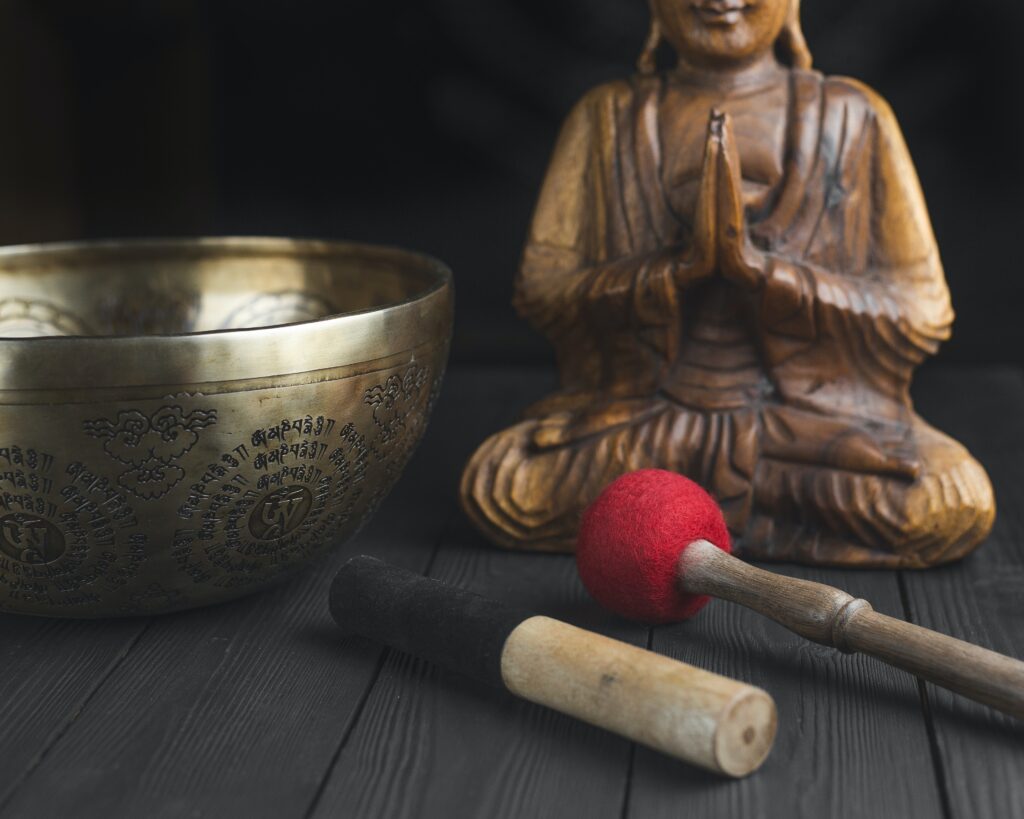
What are the Practices of Mahayana Buddhism?
Here are some of the common practices of Mahayana Buddhists:
-
Meditation: This is foundational in nearly all schools of Buddhism, including Mahayana. The types of meditation can vary widely. Zazen meditation in Zen Buddhism and visualization meditations in Pure Land Buddhism are examples of Mahayana practices.
-
Chanting: Reciting sutras, mantras, or the name of Buddhas or Bodhisattvas is a common practice. In Pure Land Buddhism, for example, practitioners often chant the name of Amitabha Buddha.
-
Devotional Practices: Making offerings, prostrating, and other forms of devotion directed toward Buddhas, bodhisattvas, and ancestors are common. Pilgrimages to sacred places are also a traditional practice.
-
Study of the Scriptures: The sutras are considered the word of the Buddha and are deeply respected and studied for their wisdom.
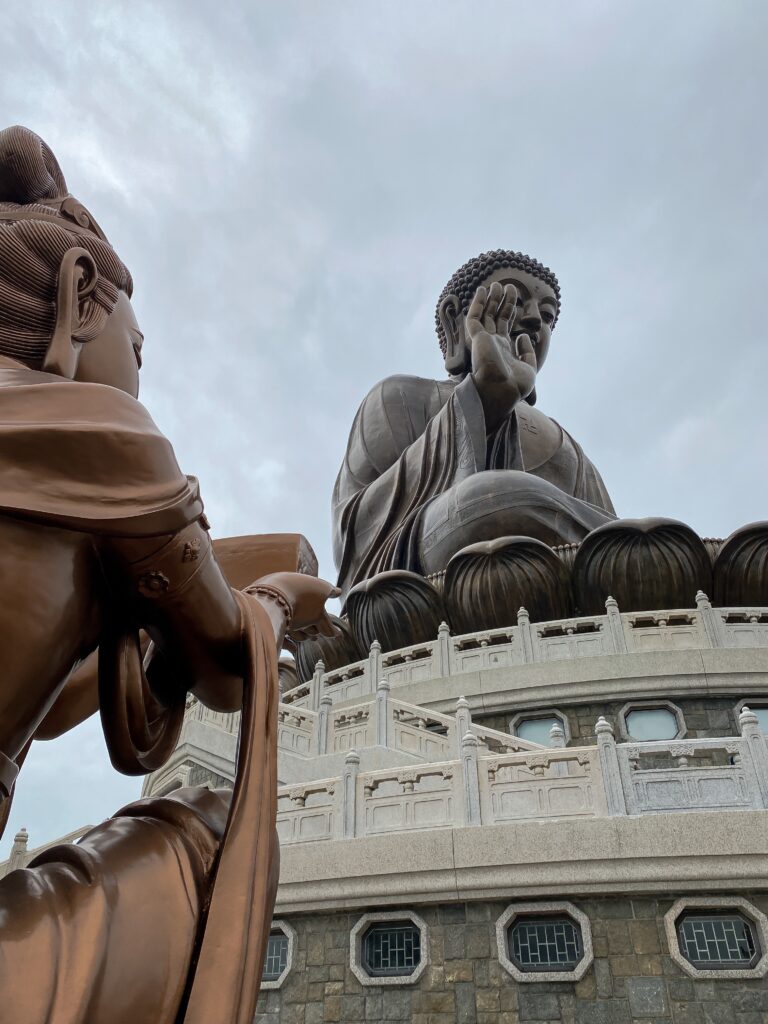
Mahayana Buddhism by Country
-
China: In China, Mahayana Buddhism has a significant influence on Chinese culture. Different schools such as Pure Land and Chan (Zen) Buddhism are prevalent. Chinese Mahayana Buddhism also incorporates elements of Taoism and Confucianism. Many traditional Chinese festivals, like the Lunar New Year and the Ghost Festival, have strong Buddhist elements.
-
Japan: Mahayana Buddhism in Japan exists in several distinct schools, including Zen, Pure Land, and Nichiren Buddhism. Japanese Buddhism often incorporates Shinto elements known as religious syncretism, and many Japanese identify with both religions which collectively is known as Shugendo.
-
Hong Kong: Some of the Hong Kong‘s most beautiful sites are its Mahayana Buddhist temples. The most famous of these is the Po Lin Monastery, home to the massive Tian Tan Buddha. Another notable temple is the Chi Lin Nunnery, an impressive wooden monastery complex known for its beautiful lotus ponds and bonsai tea gardens.
-
Vietnam: Vietnamese Buddhism is typically of the Mahayana tradition. You can find plenty of temples and legends dedicated to Avalokiteshvara in Hanoi.
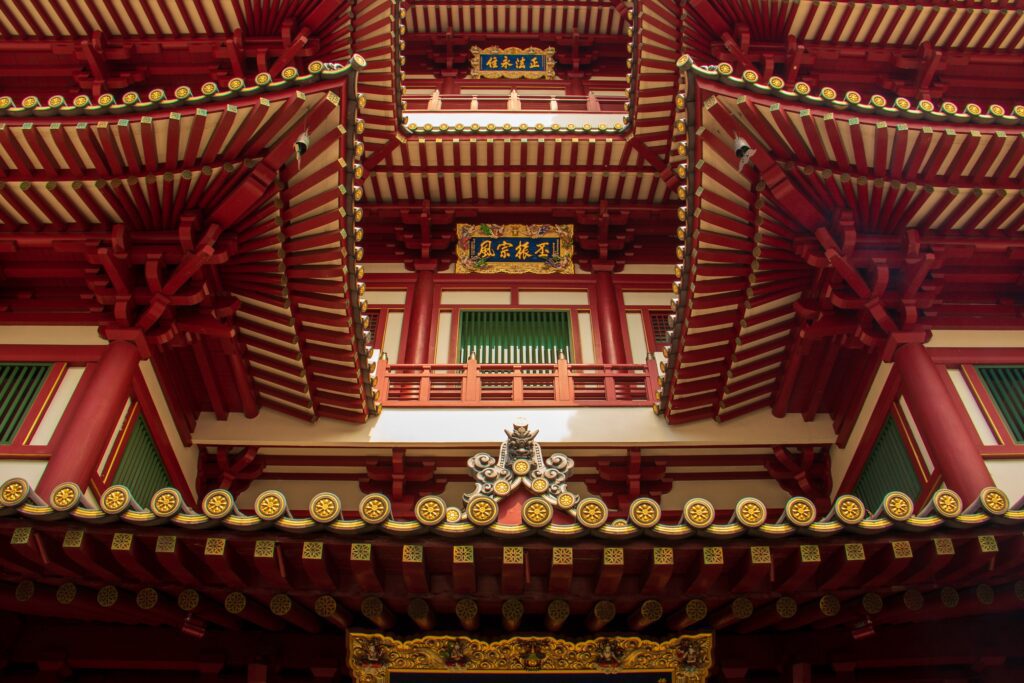
-
Singapore: While Singapore’s religious landscape is diverse due to its multi-cultural society, Mahayana Buddhism, particularly from Chinese traditions, is still quite prominent. You can find plenty of temples around the city, including the Buddha Tooth Relic Temple.
-
Taiwan: The majority of Taiwanese Buddhists follow the Mahayana tradition, with a notable presence of Pure Land and Humanistic Buddhism. Taiwanese Buddhism is known for its strong emphasis on social service and engagement.
-
Hong Kong: Some of the Hong Kong’s most beautiful sites are its Mahayana Buddhist temples. The most famous of these is the Po Lin Monastery on Lantau Island, home to the massive Tian Tan Buddha. Another notable temple is the Chi Lin Nunnery, an impressive wooden monastery complex known for its beautiful lotus ponds and bonsai tea gardens.
-
Korea: Korean Buddhism, primarily the Jogye Order, also follows the Mahayana tradition, with a significant influence from the Seon (Zen) school. Buddhism was once the state religion of South Korea, and it continues to be a vital part of Korean culture.
What are the Customs of Mahayana Buddhism?
When visiting a temple, it’s typically expected that you’ll dress modestly. This often means clothing that covers the shoulders and knees.
In many temples, it’s customary to remove your shoes before entering, as a sign of respect.
When greeting Buddhist monks or nuns, a respectful bow is usually appropriate rather than a handshake. In many Buddhist traditions, monks and nuns are not supposed to touch or be touched by a person of the opposite sex.
Many Buddhists, especially those in the Mahayana tradition, choose to avoid eating meat out of compassion for sentient beings.
- Mahayana Buddhists often use prayer beads (mala) for meditation or reciting mantras. The number of beads typically include 108, representing the 108 earthly temptations Buddha had to overcome.


